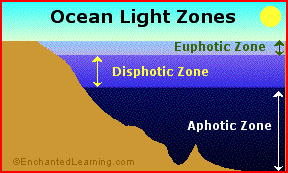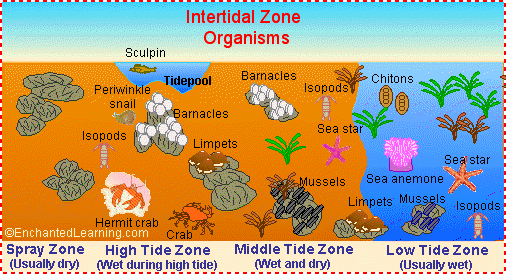Webquest Home
Introduction Letter
Friends and Family
My Home
My Biome
The Problem
What can be done?
Write to me!
My Biome: The Ocean
The
ocean
The
ocean
is the largest of all the ecosystems. They are very large bodies of
water and they cover a majority of the Earth’s surface. Ocean
regions are
separated into separate zones: intertidal, euphotic, disphotic, and
aphotic. Each has distinct differences and a large diversity of
species. The chart below shows the three light zones. I will be talking
about the intertidal and euphotic zones because they are the zones
where sea turtles live and lay their eggs.
The Euphotic or
Sunlight Zone:
The uppermost layer of the world's ocean is called the
euphotic or sunlight zone, this is where the sea turtle lives. Euphotic
means "well lit" in Greek and this zone's characteristics go well with
its name. This zone can vary greatly in depth depending on the
murkiness of the water and it usually extends out 660 feet from the
shore. The temperature of the water can also vary anywhere from 104 to
27 degrees F.
This zone receives enough light for photosynthesis to take
place and that is why there are many plants and other photosynthetic
organisms living here. Remember that photosynthesis is a process
in which sunlight and carbon dioxide gas are converted into food
(chemical energy) and oxygen gas. The primary producer this process are
phytoplankton. They are considered the first link in the ocean food
chain. It is because of this great food source that so many animals
live in this zone and most ocean life is found in this zone.
What can live here?
Many different species of fish, sharks, whales, crustaceans,
eels, echinoderms, seals, octopus, mullasks, shrimp, squids, and of
course sea turtles live in this zone.
The Intertidal
or Littoral Zone
This is where between the
high and low tide zones the ocean and land meet. This type of biome is
made of the world's coastlines. This zone is particularly rich in
nutrients and oxygen and is home to a variety of organisms. It is here
that the female sea turtles lay their eggs. Below is a chart of the
different organisms found within this zone as well as the tide
zones.

Resources:
http://www.enchantedlearning.com/biomes/
http://www.ucmp.berkeley.edu/glossary/gloss5/biome/aquatic.html